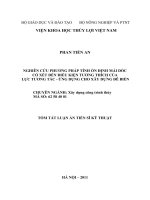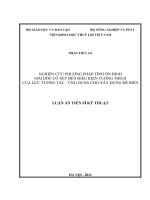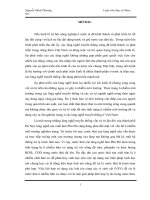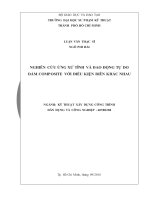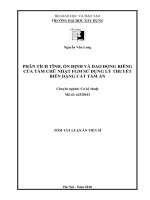NGHIÊN cứu ỨNG xử TĨNH, ổn ĐỊNH và DAO ĐỘNG dầm COMPOSITE với TIẾT DIỆN KHÁC NHAU
Bạn đang xem bản rút gọn của tài liệu. Xem và tải ngay bản đầy đủ của tài liệu tại đây (5.34 MB, 242 trang )
MINISTRY OF EDUCATION AND TRAINING
HO CHI MINH CITY UNIVERSITY OF TECHNOLOGY AND EDUCATION
NGUYEN NGOC DUONG
VIBRATION, BUCKLING AND STATIC ANALYSIS OF LAMINATED
COMPOSITE BEAMS WITH VARIOUS CROSS-SECTIONS
Ph.D THESIS
MAJOR: ENGINEERING MECHANICS
HCMC, December 2019
Scanned with CamScanner
Scanned with CamScanner
Declaration
I declare that this thesis is all my own work based on instruction of Associate
Professor Dr. Trung-Kien Nguyen and Dr. Thuc P. Vo.
The work contained in this thesis has not been submitted for any other award.
Name: Ngoc-Duong Nguyen
Signature:
i
Acknowledgement
Firstly, I wish to express my deep gratitude to my advisor, Associate Professor
Dr. Trung-Kien Nguyen, for his warm guidance, suggestions and support during my
study. He has influenced my career by coaching me the work ethics and
responsibilities, along with research skills, which are required of a good researcher.
The completion of this work would not have been possible without his detailed
advice, constructive criticism and constant encouragement and patience.
I am also extremely grateful to Dr. Thuc P. Vo at Northumbria University who
generously spent a great deal of time providing me with alternative viewpoints to
my ideas through many helpful discussions. His invaluable knowledge, experience
and moral support proved to be of inestimable value to the revision and completion
of this thesis.
In addtion, I am grateful to Dr. Huu-Tai Thai for his comments in my
publications, and Mr. Thien-Nhan Nguyen for sharing his Matlab code.
My special thanks are extended to my colleagues at Department of Structural
Engineering in Falcuty of Civil Engineering, HCMC University Technology and
Education, who have offered me intellectual stimulation, friendship and provided a
warm and inspiring environment.
Finally, I wish to express my deep appreciation to my family and wife for their
continued encouragement and support during my study. Without their presence, this
work would have never been possible.
Ngoc-Duong Nguyen
ii
Abstract
Composite materials are widely used in many engineering fields owing to their
high stiffness-to-weight, strength-to-weight ratios, low thermal expansion, enhanced
fatigue life and good corrosive resistance. Among them, laminated composite beams
are popular in application and attract a huge attention from reseacher to study the
their structural behaviours. Many theories are proposed for the bending, buckling
and vibration analysis. They can be divided into classical beam theory (CBT), firstorder beam theory (FOBT), higher-order beam theory (HOBT) and quasi-three
dimension (quasi-3D) beam theory. It should be noted that classical continuum
mechanics theories are just suitable for macro beams. For analysing microbeams,
researchers proposed many non-classical theories. Among them, the modified
couple stress theory (MCST) is the most popular and commonly applied owing to
its simplicity in formulation and programming. In order to accurately predict
behaviours of beams, a large number of methods are developed. Numerical
approaches are used increasingly, however, analytical methods are also used by
researchers owing to their accuracy and efficiency. Among analytical approaches,
Ritz method is the most general one, which accounts for various boundary
conditions, however, it has seldom been used to analyse the bending, buckling and
free vibration behaviours of beams. This is also the main motivation of this study.
This dissertation focuses on propsing new approximation functions to analyse
laminated composite beams with various cross-sections and boundary conditions. The
displacement field is based on the FOBT, HOBT and quasi-3D theories. Size-dependent
effect for microbeams is investigated using the MCST. Poisson’s effect is considered by
integrating in the constitutive equations. The governing equations of motion are derived
from Lagrange’s equations. Numerical results for beam with various boundary
conditions are presented and compared with existing ones available in the literature.
The effects of fiber angle, length-to-height ratio, material anisotropy, shear and normal
strains on the displacements, stresses, natural frequencies, mode shape and buckling
loads of the composite beams are investigated. Some of numerical
iii
results are presented at the first time and can be used as the benchmark results for
numerical methods. Besides, a study on efficacy of approximation functions for
analysis of laminated composite beams with simply-supported boundary conditions
is carried out.
iv
List of Publications
ISI papers with peer-reviews:
1. N.-D. Nguyen, T.-K. Nguyen, T.P. Vo, T.-N. Nguyen, and S. Lee, Vibration
and buckling behaviours of thin-walled composite and functionally graded
sandwich I-beams, Composites Part B: Engineering. 166 (2019) 414-427.
2. N.-D. Nguyen, T.-K. Nguyen, T.P. Vo, and H.-T. Thai, Ritz-based analytical
solutions for bending, buckling and vibration behavior of laminated composite
beams, International Journal of Structural Stability and Dynamics. 18(11) (2018)
1850130.
3. N.-D. Nguyen, T.-K. Nguyen, H.-T. Thai, and T.P. Vo, A Ritz type solution
with exponential trial functions for laminated composite beams based on the
modified couple stress theory, Composite Structures. 191 (2018) 154-167.
4. N.-D. Nguyen, T.-K. Nguyen, T.-N. Nguyen, and H.-T. Thai, New Ritzsolution shape functions for analysis of thermo-mechanical buckling and vibration
of laminated composite beams, Composite Structures. 184 (2018) 452-460.
5. T.-K. Nguyen, N.-D. Nguyen, T.P. Vo, and H.-T. Thai, Trigonometric-series
solution for analysis of laminated composite beams, Composite Structures. 160
(2017) 142-151.
Domestic papers with peer-reviews:
6. T.-K. Nguyen and N.-D. Nguyen, Effects of transverse normal strain on
bending of laminated composite beams, Vietnam Journal of Mechanics. 40(3)
(2018) 217-232.
7. X.-H. Dang, N.-D. Nguyen, T.-K. Nguyen, Dynamic analysis of composite
beams resting on winkler foundation, Vietnam Journal of Construction (8-2017)
123-129.
8. N.-D. Nguyen, T.-K. Nguyen, T.-N. Nguyen, Ritz solution for buckling
analysis of thin-walled composite channel beams based on a classical beam theory,
Journal of Science and Technology in Civil Engineering (STCE)-NUCE. 13(3)
(2019) 34-44.
v
Conference papers:
9. N.-D. Nguyen, T.-K. Nguyen, T.-N. Nguyen, and T.P. Vo, Bending Analysis
of Laminated Composite Beams Using Hybrid Shape Functions, International
Conference on Advances in Computational Mechanics. (2017), (503-517).
10. N.-D. Nguyen, T.-K. Nguyen, Free vibration analysis of laminated
composite beams based on higher – order shear deformation theory. Proceeding of
National Confrence-Composite Material and Structure (2016) 157-164.
11. N.-D. Nguyen, T.-K. Nguyen, and T.P. Vo, Hybrid-shape-functions for free
vibration analysis of thin-walled laminated composite I-beams with different
boundary conditions, Proceeding of National Mechanical Confrence (2017) 424-433
vi
Table of content
Declaration............................................................................................................................................... i
Acknowledgement................................................................................................................................ ii
Abstract................................................................................................................................................... iii
List of Publications.............................................................................................................................. v
Table of content.................................................................................................................................. vii
List of Figures....................................................................................................................................... xi
List of Tables........................................................................................................................................ xv
Nomenclature..................................................................................................................................... xix
Abbreviations.................................................................................................................................... xxii
Chapter 1. INTRODUCTION.......................................................................................................... 1
1.1. Composite material................................................................................................................. 1
1.1.1. Fiber and matrix............................................................................................................... 1
1.1.2. Lamina and laminate...................................................................................................... 1
1.1.3. Applications....................................................................................................................... 2
1.2. Review......................................................................................................................................... 3
1.2.1. Literature review.............................................................................................................. 4
1.2.2. Objectives of the thesis.................................................................................................. 6
1.2.3. Beam theory....................................................................................................................... 7
1.2.4. Constitutive relation..................................................................................................... 10
1.3. Organization............................................................................................................................ 13
Chapter 2. ANALYSIS OF LAMINATED COMPOSITE BEAMS BASED ON A
HIGH-ORDER BEAM THEORY............................................................................................... 15
2.1. Introduction............................................................................................................................. 15
2.2. Beam model based on the HOBT................................................................................... 16
2.2.1. Kinetic, strain and stress relations.......................................................................... 16
2.2.2. Variational formulation............................................................................................... 17
2.3. Numerical examples............................................................................................................. 20
2.3.1. Static analysis................................................................................................................. 22
2.3.2. Vibration and buckling analysis............................................................................... 25
vii
2.4. Conclusion............................................................................................................................... 31
Chapter 3. VIBRATION AND BUCKLING ANALYSIS OF LAMINATED
COMPOSITE BEAMS UNDER THERMO-MECHANICAL LOAD......................... 32
3.1. Introduction............................................................................................................................. 32
3.2. Theoretical formulation...................................................................................................... 33
3.2.1. Beam model based on the HOBT........................................................................... 34
3.2.2. Solution procedure........................................................................................................ 34
3.3. Numerical results................................................................................................................... 36
3.3.1. Convergence study........................................................................................................ 37
3.3.2. Vibration analysis.......................................................................................................... 38
3.3.3. Buckling analysis.......................................................................................................... 41
3.4. Conclusions............................................................................................................................. 47
Chapter 4. EFFECT OF TRANSVERSE NORMAL STRAIN ON BEHAVIOURS
OF LAMINATED COMPOSITE BEAMS.............................................................................. 48
4.1. Introduction............................................................................................................................. 48
4.2. Theoretical formulation...................................................................................................... 49
4.2.1. Kinetic, strain and stress relations.......................................................................... 49
4.2.2. Variational formulation............................................................................................... 50
4.3. Numerical results................................................................................................................... 55
4.3.1. Cross-ply beams............................................................................................................. 56
4.3.2. Angle-ply beams............................................................................................................ 62
4.3.3. Arbitrary-ply beams...................................................................................................... 70
4.4. Conclusions............................................................................................................................. 74
Chapter 5. SIZE DEPENDENT BEHAVIOURS OF MICRO GENERAL
LAMINATED COMPOSITE BEAMS BASED ON MODIFIED COUPLE STRESS
THEORY............................................................................................................................................... 76
5.1. Introduction............................................................................................................................. 76
5.2. Theoretical formulation...................................................................................................... 78
5.2.1. Kinematics....................................................................................................................... 78
5.2.2. Constitutive relations................................................................................................... 80
viii
5.2.3. Variational formulation............................................................................................... 81
5.2.4. Ritz solution.................................................................................................................... 82
5.3. Numerical results................................................................................................................... 83
5.3.1. Convergence and accuracy studies......................................................................... 83
5.3.2. Static analysis................................................................................................................. 87
5.3.3. Vibration and buckling analysis............................................................................... 94
5.4. Conclusions............................................................................................................................. 99
Chapter 6. ANALYSIS OF THIN-WALLED LAMINATED COMPOSITE BEAMS
BASED ON FIRST-ORDER BEAM THEORY.................................................................. 101
6.1. Introduction........................................................................................................................... 101
6.2. Theoretical formulation.................................................................................................... 103
6.2.1. Kinematics..................................................................................................................... 103
6.2.2. Constitutive relations................................................................................................. 105
6.2.3. Variational formulation............................................................................................. 107
6.2.4. Ritz solution.................................................................................................................. 109
6.3. Numerical results................................................................................................................ 114
6.3.1. Convergence study..................................................................................................... 115
6.3.2. Composite I-beams..................................................................................................... 117
6.3.3. Functionally graded sandwich I-beams.............................................................. 129
6.3.4. Composite channel-beams....................................................................................... 136
6.4. Conclusions........................................................................................................................... 139
Chapter 7. CONVERGENCY, ACCURARY AND NUMERICAL STABILITY OF
RITZ METHOD............................................................................................................................... 141
7.1. Introduction........................................................................................................................... 141
7.2. Results of comparative study.......................................................................................... 144
7.2.1. Convergence................................................................................................................. 144
7.2.2. Computational time.................................................................................................... 148
7.2.3. Numerical stability..................................................................................................... 150
7.3. Conclusions........................................................................................................................... 150
Chapter 8. CONCLUSIONS AND RECOMMENDATIONS........................................ 152
ix
8.1. Conclusions........................................................................................................................... 152
8.2. Recommendations.............................................................................................................. 152
APPENDIX A................................................................................................................................... 154
The coefficients in Eq. (1.19)...................................................................................................... 154
The coefficients in Eq. (1.20)...................................................................................................... 154
The coefficients in Eqs. (1.21) and (1.22).............................................................................. 154
The coefficients in Eq. (1.23)...................................................................................................... 154
The coefficients in Eq. (1.24)...................................................................................................... 155
The coefficients in Eq. (1.25)...................................................................................................... 155
The coefficients in Eq. (3.3)........................................................................................................ 155
APPENDIX B................................................................................................................................... 156
The coefficients in Eq. (6.48)...................................................................................................... 156
The coefficients in Eq. (6.51)...................................................................................................... 157
References.......................................................................................................................................... 158
x
List of Figures
Figure 1.1. Composite material classification [1] ...................................................... 1
Figure 1.2. Various types of fiber-reinforced composite lamina [1] ..........................
2
Figure 1.3. A laminate made up of laminae with different fiber orientations [1] ...... 2
Figure 1.4. Composite material applied in engineering field .................................... 3
Figure 1.5. Material used in Boeing 787 ................................................................... 3
Figure 1.6. Geometry and coordinate of a rectangular laminated composite beam.
.
8
Figure 2.1. Geometry and coordinate of a laminated composite beam.................... 1
6
Figure 2.2. Distribution of the normalized stresses (σ
0
0
0
0
xx
, σxz ) through the beam
0
depth of (0 /90 /0 ) and (0 /90 ) composite beams with simply-supported boundary
conditions (MAT II.2, E1/E2 = 25). ............................................................................
2
4
Figure 2.3. Effects of the fibre angle change on the normalized transverse
displacement of ( θ / −θ ) s composite beams ( L / h = 10 , MAT II.2, E1/E2 = 25). ......... 2
5
0
0
0
0
0
Figure 2.4.The first three mode shapes of (0 /90 /0 ) and (0 /90 ) composite beams
with simply-supported boundary conditions (L/h = 10, MAT I.2, E 1/E2 = 40). ........ 2
8
Figure 2.5. Effects of material anisotropy on the normalized fundamental frequencies
0
0
0
0
0
and critical buckling loads of (0 /90 /0 ) and (0 /90 ) composite beams with
simplysupported boundary conditions ( L / h = 10 , MAT I.2). .................................... 2
9
Figure 2.6. Effects of the fibre angle change on the normalized fundamental
frequencies and critical buckling loads of ( θ / −θ ) s composite beams ( L / h = 15 ,
MAT
III.2) ........................................................................................................................... 3
0
Figure 2.7. Effects of the length-to-height ratio on the normalized fundamental
frequencies and critical buckling loads of ( 30 / −30) s composite beams ( L / h = 15 ,
MAT III.2) ..................................................................................................................
0
0
0
0
3
1
0
Figure 3.1. Variation of fundamental frequency of (0 /90 /0 ) and (0 /90 ) beams
(MAT II.3) with respect to uniform temperature rise ∆T. ..........................................
4
1
Figure 3.2. Effect of α 2* /α1* ratio on nondimensional critical buckling temperature of
(00/900/00) composite beams (MAT I.3, E1/E2 = 20, L / h = 10 ). ................................ 47
xi
Figure 4.1. Distribution of nondimensional transverse displacement through the
0
0
0
0
0
thickness of (0 /90 ) and (0 /90 /0 ) composite beams with S-S boundary condition
(MAT II.4).
...................................................................................................................................................................
61
Figure 4.2. Distribution of nondimensional transverse displacement through the
0
0
0
0
0
thickness of (0 /90 ) and (0 /90 /0 ) composite beams with C-F boundary condition
(MAT II.4).
...................................................................................................................................................................
61
Figure 4.3. Distribution of nondimensional transverse displacement through the
0
0
0
0
0
thickness of (0 /90 ) and (0 /90 /0 ) composite beams with C-C boundary condition
(MAT II.4).
...................................................................................................................................................................
62
Figure 4.4. The nondimensional mid-span transverse displacement with respect to
the fiber angle change of composite beams with S-S boundary condition ( L / h = 3 ,
MAT II.4).
...................................................................................................................................................................
68
Figure 4.5. The nondimensional mid-span transverse displacement with respect to
the fiber angle change of composite beams with C-F boundary condition ( L / h =
3,
MAT II.4).
...................................................................................................................................................................
69
Figure 4.6. The nondimensional mid-span transverse displacement with respect to
the fiber angle change of composite beams with C-C boundary condition ( L / h =
3,
MAT II.4).
...................................................................................................................................................................
70
Figure 4.7. Effects of the fibre angle change on the nondimensional fundamental
frequency of ( θ / −θ ) s composite beams (MAT IV.4).
...................................................................................................................................................................
74
Figure 5.1. Geometry and coordinate of a laminated composite beam
...................................................................................................................................................................
78
Figure 5.2. Rotation displacement about the x -, y -axes
...................................................................................................................................................................
79
Figure 5.3. Comparison of critical buckling loads of S-S beams (MAT I.5).
...................................................................................................................................................................
86
Figure 5.4. Comparison of fundamental frequencies of S-S beams (MAT I.5).
...................................................................................................................................................................
86
Figure 5.5. Comparison of displacement and normal stress of ( 90 0 / 0 0 / 900 ) S-S
beams (MAT II.5).
...................................................................................................................................................................
87
Figure 5.6. Effect of MLSP on displacements of S-S beams (MAT II.5, L / h = 4 ). .. 91
Figure 5.7. Effect of MLSP on displacements of C-F beams (MAT II.5, L / h = 4 ). . 92
xii
Figure 5.8. Effect of MLSP on displacements of C-C beams (MAT II, L / h = 4 ).
................................................................................................................................
93
Figure 5.9. Effect of MLSP on displacements of beams with various BCs (MAT II.5, L / h = 4 )
93
Figure 5.10. Effect of MLSP on through-thickness distribution of stresses of
...................................................................................................................................................................
94
Figure 5.11. Effect of MLSP on through-thickness distribution of stresses of
...................................................................................................................................................................
94
Figure 5.12. Effect of MLSP on frequencies of beams with various BC (MAT III.5,
L/h= 5)
..................................................................................................................................................................
99
Figure 5.13. Effect of MLSP on buckling loads of beams with various BCs (MAT III.5,
L/h= 5)
..................................................................................................................................................................
99
Figure 6.1. Thin-walled coordinate systems.......................................................................... 103
Figure 6.2. Geometry of thin-walled I-beams....................................................................... 107
Figure 6.3. Variation of the fundamental frequencies (Hz) of thin-walled C-C Ibeams with respect to fiber angle.............................................................................................. 118
Figure 6.4. Variation of the critical buckling loads (N) of thin-walled C-C I-beams
with respect to fiber angle............................................................................................................ 119
Figure 6.5. Shear effect on the fundamental frequency for various BCs.................... 123
Figure 6.6. Shear effect on the critical buckling loads for various BCs.....................124
Figure 6.7. Shear effect on first three natural frequencies of thin-walled C-C I-beams 125
Figure 6.8. Variation of E33 / E77 ratio with respect to η................................................ 125
Figure 6.9. Mode shape 1 of thin-walled C-C I-beams..................................................... 126
Figure 6.10. Mode shape 2 of thin-walled C-C I-beams................................................... 126
Figure 6.11. Mode shape 3 of thin-walled C-C I-beams................................................... 127
Figure 6.12. Non-dimensional fundamental frequency for various BCs....................128
Figure 6.13. Non-dimensional critical buckling load for various BCs.......................128
Figure 6.14. Non-dimensional fundamental frequency of thin-walled FG sandwich
I-beams................................................................................................................................................ 129
Figure 6.15. Non-dimensional fundamental frequency with respect to α1, α2 (α1 = α2
, β = 0.3 and p = 1 0 )....................................................................................................................... 131
xiii
Figure 6.16. Non-dimensional critical buckling load with respect to α1, α2 ( β = 0.3
and p = 1 0 )........................................................................................................................................ 132
Figure 6.17. Non-dimensional fundamental frequency with respect to β...................133
Figure 6.18. Non-dimensional critical buckling load with respect to β......................133
Figure 6.19. Shear effect on fundamental frequency for various BCs.........................134
Figure 6.20. Shear effect on critical buckling load for various BCs............................135
Figure 6.21. Shear effect on first three frequency of C-C I-beams with respect to
material parameter.......................................................................................................................... 135
Figure 6.22. Geometry of thin-walled composite channel beams................................. 136
Figure 6.23. Shear effect on fundamental frequency for various BCs.........................138
Figure 6.24. Shear effect on critical buckling load for various BCs............................139
Figure 7.1. Distance of fundamental frequency................................................................... 145
Figure 7.2. Distance of critical buckling load...................................................................... 146
Figure 7.3. Distance of deflection............................................................................................. 147
Figure 7.4. Elapsed time to compute frequency................................................................... 149
Figure 7.5. Elapsed time to compute critical buckling load............................................ 149
Figure 7.6. Elapsed time to compute deflection................................................................... 149
Figure 7.7. Maximun eigen value-to-Minimun eigen value ratio.................................. 150
xiv
List of Tables
Table 1.1. Shear variation functions f ( z )
...................................................................................................................................................................
10
Table 2.1. Approximation functions of the beams.
...................................................................................................................................................................
19
Table 2.2. Kinematic BCs of the beams.
...................................................................................................................................................................
19
Table 2.3. Convergence studies for the non-dimensional fundamental frequencies,
0
0
0
critical buckling loads and mid-span displacements of (0 /90 /0 ) composite beams
(MAT I.2, L / h = 5 , E1/E2 = 40).
...................................................................................................................................................................
21
0
0
0
Table 2.4. Normalized mid-span displacements of (0 /90 /0 ) composite beam under
a uniformly distributed load (MAT II.2, E1/E2 = 25).
...................................................................................................................................................................
22
0
0
Table 2.5. Normalized mid-span displacements of (0 /90 ) composite beam under a
uniformly distributed load (MAT II.2, E1/E2 = 25).
...................................................................................................................................................................
23
0
0
0
0
0
Table 2.6. Normalized stresses of (0 /90 /0 ) and (0 /90 ) composite beams with
simply-supported boundary conditions (MAT II.2, E1/E2 = 25).
...................................................................................................................................................................
23
0
0
0
0
0
Table 2.7. Normalized critical buckling loads of (0 /90 /0 ) and (0 /90 ) composite
beams (MAT I.2, E1/E2 = 40)
...................................................................................................................................................................
25
0
0
0
0
0
Table 2.8. Normalized critical buckling loads of (0 /90 /0 ) and (0 /90 ) composite
beams with simply-supported boundary conditions (MAT I.2 and II.2, E1/E2 = 10).
26
0
0
0
0
0
Table 2.9. Normalized fundamental frequencies of (0 /90 /0 ) and (0 /90 )
composite beams (MAT I.2, E1/E2 = 25).
...................................................................................................................................................................
27
Table 2.10. Normalized fundamental frequencies of ( θ / −θ ) s composite beams with
respect to the fibre angle change ( L / h = 15 MAT III.2).
...................................................................................................................................................................
30
Table 3.1. Approximation functions and kinematic BC of the beams.
...................................................................................................................................................................
35
Table 3.2. Material properties of laminated composite beams.
...................................................................................................................................................................
37
Table 3.3. Convergence study of nondimensional critical buckling load and
0
0
0
fundamental frequency of (0 /90 /0 ) beams (MAT I.3, L / h = 5 , E1/E2 = 40).
...................................................................................................................................................................
38
0
0
0
Table 3.4. Nondimensional fundamental frequency of (0 /90 /0 ) beams (MAT I.3,
E1/E2 = 40).
...................................................................................................................................................................
39
xv
0
0
Table 3.5. Nondimensional fundamental frequency of (0 /90 ) beams (MAT
I.3, E1/E2 = 40)........................................................................................................
0
0
0
0
4
0
0
Table 3.6. The fundamental frequency (Hz) of (0 /90 /0 ) and (0 /90 ) beams with
various boundary conditions (MAT II.3). ................................................................. 4
1
0
0 0
Table 3.7. Nondimensional critical buckling load of (0 /90 /0 ) beams (MAT I.3,
E1/E2 = 40). ............................................................................................................... 4
2
0
0
Table 3.8. Nondimensional critical buckling load of (0 /90 ) beams (MAT
I.3, E1/E2 = 40)........................................................................................................
4
2
Table 3.9. Nondimensional critical buckling load of angle-ply beams (MAT
I.3, E1/E2 = 40)........................................................................................................
4
3
0
0
0
Table 3.10. Nondimensional critical buckling temperature of (0 /90 /0 ) beams
(MAT I.3, E1/E2 = 40, α* /α* = 3). ............................................................................. 4
4
2
1
Table 3.11. Nondimensional critical buckling temperature of unsymmetric C-C
beams (MAT I.3, E1/E2 = 20, α*
/ α* 4
= 3) ................................................................... 4
2
1
0
0
0
0
Table 3.12. Nondimensional critical buckling temperature of (0 /90 ) composite
beams (MAT I.3, L / h = 10 ). ..................................................................................... 4
5
0
Table 3.13. Nondimensional critical buckling temperature of (0 /90 /0 ) composite
beams (MAT I.3, L / h =
4
6
10 ) ......................................................................................
Table 4.1. Approximation functions and kinematic BCs of beams. .......................... 5
3
Table 4.2. Material properties of laminated composite beams. ............................... 5
5
Table 4.3. Convergence studies for the nondimensional fundamental frequencies,
0
0
critical buckling loads and mid-span displacements of (0 /90 ) composite beams
(MAT I.4, L / h = 5 , E1/E2 = 40). ............................................................................... 5
6
0
0 0
0
0
Table 4.4. Nondimensional fundamental frequencies of (0 /90 /0 ) and (0 /90 )
composite beams (MAT I.4, E1/E2 = 40). .................................................................. 5
7
0
0 0
0
0
Table 4.5. Nondimensional critical buckling loads of (0 /90 /0 ) and (0 /90 )
composite beams (MAT I.4, E1/E2 = 40). .................................................................. 5
8
0
0 0
0
0
Table 4.6. Nondimensional mid-span displacements of (0 /90 /0 ) and (0 /90 )
composite beams under a uniformly distributed load (MAT II.4). ........................... 5
9
xvi
0
0
0
0
0
Table 4.7. Nondimensional stresses of (0 /90 /0 ) and (0 /90 ) composite beams
with S-S boundary condition under a uniformly distributed load (MAT II.4). ......... 6
0
0
0
0
Table 4.8. Nondimensional fundamental frequencies of (0 /θ /0 ) and (0 /θ )
composite beams (MAT I.4, E1/E2 = 40). .................................................................. 6
3
0
0
0
Table 4.9. Nondimensional critical buckling loads of (0 /θ /0 ) and (0 /θ )
composite beams (MAT I.4, E1/E2 = 40). .................................................................. 6
4
0
0
0
Table 4.10. Nondimensional mid-span displacements of (0 /θ /0 ) and (0 /θ )
composite beams under a uniformly distributed load (MAT II.4). ........................... 6
5
0
0
0
Table 4.11. Nondimensional stresses of (0 /θ /0 ) and (0 /θ ) composite beams with
S-S boundary condition under a uniformly distributed load (MAT II.4). ................. 6
6
Table 4.12. Fundamental frequencies (Hz) of single-layer composite beam with C-F
boundary condition (MAT III.4). ...............................................................................
7
1
Table 4.13. Nondimensional fundamental frequencies of arbitrary-ply laminated
composite beams (MAT IV.4). ................................................................................... 7
1
Table 4.14. Nondimensional fundamental frequencies, critical buckling loads and
mid-span displacements of ( θ / −θ ) s composite beams (MAT IV.4). ........................
7
2
Table 5.1. Approximation functions and essential BCs of beams ............................. 8
3
Table 5.2. Material properties of laminated composite beams considered in this
study. ......................................................................................................................... 8
4
Table 5.3. Convergence studies for ( 0 0 / 90 0 / 00 ) composite beams (MAT I.5, L / h = 5
). ................................................................................................................................. 85
Table 5.4. Displacement of S-S beams (MAT II.5).................................................... 88
Table 5.5. Displacement of C-F beams (MAT II.5). ................................................. 89
Table 5.6. Displacement of C-C beams (MAT II.5). ................................................. 90
Table 5.7. Fundamental frequencies of (θ / −θ ) beams (MAT III.5). ........................ 95
Table 5.8. Fundamental frequencies of ( 0 0 / θ ) beams (MAT III.5). ........................
96
Table 5.9. Buckling loads of (θ / −θ ) beams (MAT III.5). ......................................... 97
Table 5.10. Buckling loads of ( 0 0 / θ ) beams (MAT III.5). .......................................
98

